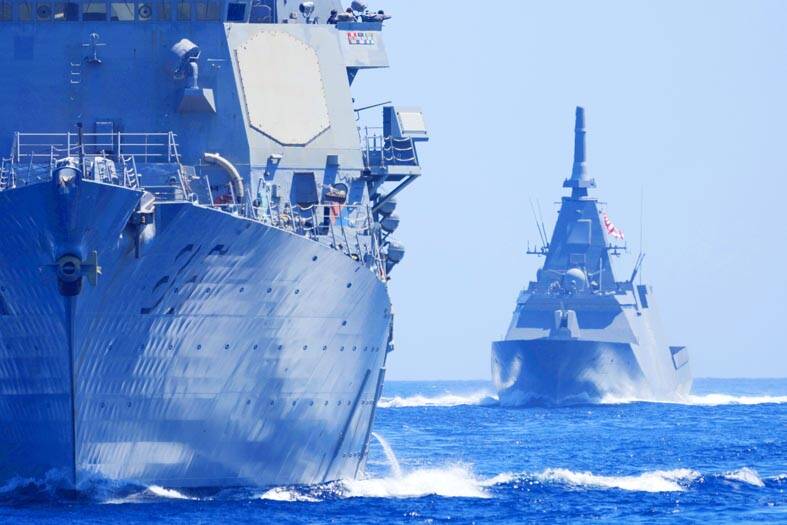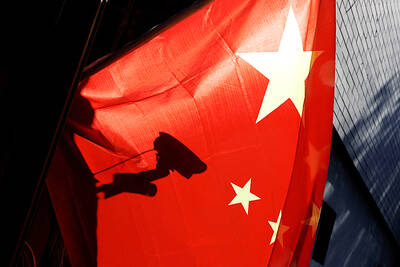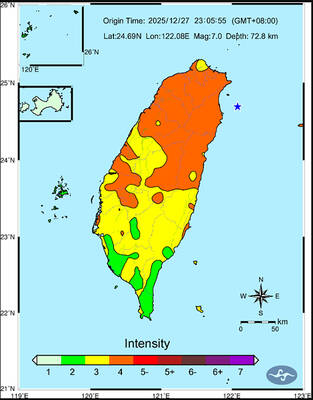The Philippines is working behind the scenes to enhance its defensive cooperation with Taiwan, the Washington Post said in a report published on Monday.
“It would be hiding from the obvious to say that Taiwan’s security will not affect us,” Philippine Secretary of National Defense Gilbert Teodoro Jr told the paper in an interview on Thursday last week.
Although there has been no formal change to the Philippines’ diplomatic stance on recognizing Taiwan, Manila is increasingly concerned about Chinese encroachment in the South China Sea, the report said.

Photo: AP
The number of Chinese vessels in the seas around the Philippines, as well as Chinese cybersecurity attacks and espionage, have increased, the report said, citing information from the Philippine National Security Council.
The Philippines is “entitled” to negotiate its relationship with Taiwan, given that prior attempts to ease tensions with China have so far found no success, the report quoted Teodoro as saying.
Speaking on condition of anonymity, officials told the newspaper that security cooperation with Taiwan is “further along” than publicly disclosed, following a new policy by Philippine President Ferdinand Marcos Jr that reduced restrictions on exchanges between the two countries.
Filipino academics with ties to the nation’s defense establishment earlier this year participated in forums with high-ranking Taiwanese generals to better understand security thinking in the country, the paper said.
Taiwan’s Coast Guard Administration and the Philippine Coast Guard recently carried out joint patrols of the Bashi Channel, it added.
Taiwan also sent observers to a joint US-Philippine-Japan military exercise called Kamandag that took place in the Batanes islands, it said.
Batanes is the Philippines’ northernmost province and less than 200km south of Taiwan.
Although Philippine officials did not say the exercise targeted China, the report cited analysts who said they were clearly meant to counter Chinese ships.
An anonymous Taiwanese adviser said that although personnel did not participate, the two countries are “closer and closer” in defense matters, the newspaper reported.
In a news release last month, a spokesperson for the Chinese Ministry of National Defense said that the Philippines has “tied itself to the US war chariot, and become a coconspirator in destabilizing the region.”
Due to the Philippines’ proximity to Taiwan, Taiwan’s large Filipino population and US defense agreements with the country, one Filipino academic told the paper that “we’d be kidding ourselves not to see the necessity of working with Taiwan.”
The report quoted another professor as saying that “Taiwan is our buffer from an expansionist China.”
The recent visit to Taiwan by two senior Philippine officials and one former official caused “severe diplomatic complications,” Philippine Secretary of Foreign Affairs Theresa Lazaro said in a letter that the newspaper obtained.
The report also quoted Democratic Progressive Party Legislator Wang Ting-yu (王定宇) as saying that while the two countries were diplomatically distant before, they have “started to smile at each other.”

A magnitude 7.0 earthquake struck off Yilan at 11:05pm yesterday, the Central Weather Administration (CWA) said. The epicenter was located at sea, about 32.3km east of Yilan County Hall, at a depth of 72.8km, CWA data showed There were no immediate reports of damage. The intensity of the quake, which gauges the actual effect of a seismic event, measured 4 in Yilan County area on Taiwan’s seven-tier intensity scale, the data showed. It measured 4 in other parts of eastern, northern and central Taiwan as well as Tainan, and 3 in Kaohsiung and Pingtung County, and 2 in Lienchiang and Penghu counties and 1

FOREIGN INTERFERENCE: Beijing would likely intensify public opinion warfare in next year’s local elections to prevent Lai from getting re-elected, the ‘Yomiuri Shimbun’ said Internal documents from a Chinese artificial intelligence (AI) company indicated that China has been using the technology to intervene in foreign elections, including propaganda targeting Taiwan’s local elections next year and presidential elections in 2028, a Japanese newspaper reported yesterday. The Institute of National Security of Vanderbilt University obtained nearly 400 pages of documents from GoLaxy, a company with ties to the Chinese government, and found evidence that it had apparently deployed sophisticated, AI-driven propaganda campaigns in Hong Kong and Taiwan to shape public opinion, the Yomiuri Shimbun reported. GoLaxy provides insights, situation analysis and public opinion-shaping technology by conducting network surveillance

‘POLITICAL GAME’: DPP lawmakers said the motion would not meet the legislative threshold needed, and accused the KMT and the TPP of trivializing the Constitution The Legislative Yuan yesterday approved a motion to initiate impeachment proceedings against President William Lai (賴清德), saying he had undermined Taiwan’s constitutional order and democracy. The motion was approved 61-50 by lawmakers from the main opposition Chinese Nationalist Party (KMT) and the smaller Taiwan People’s Party (TPP), who together hold a legislative majority. Under the motion, a roll call vote for impeachment would be held on May 19 next year, after various hearings are held and Lai is given the chance to defend himself. The move came after Lai on Monday last week did not promulgate an amendment passed by the legislature that

AFTERMATH: The Taipei City Government said it received 39 minor incident reports including gas leaks, water leaks and outages, and a damaged traffic signal A magnitude 7.0 earthquake struck off Taiwan’s northeastern coast late on Saturday, producing only two major aftershocks as of yesterday noon, the Central Weather Administration (CWA) said. The limited aftershocks contrast with last year’s major earthquake in Hualien County, as Saturday’s earthquake occurred at a greater depth in a subduction zone. Saturday’s earthquake struck at 11:05pm, with its hypocenter about 32.3km east of Yilan County Hall, at a depth of 72.8km. Shaking was felt in 17 administrative regions north of Tainan and in eastern Taiwan, reaching intensity level 4 on Taiwan’s seven-tier seismic scale, the CWA said. In Hualien, the